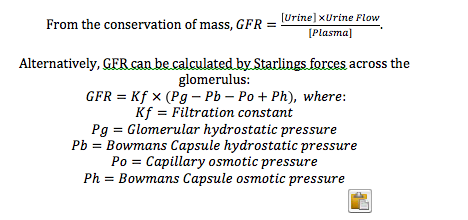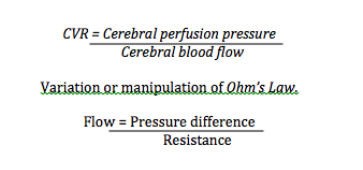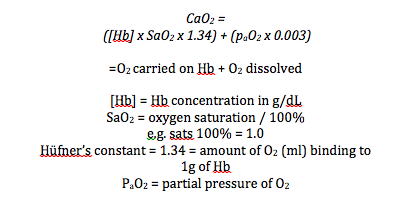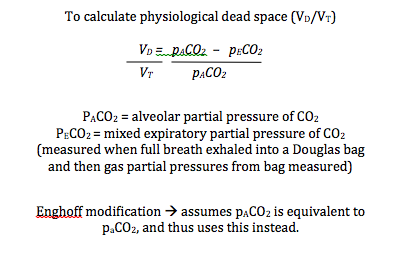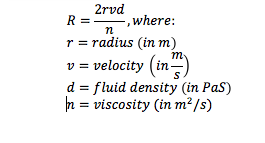Definitions
Bohr Effect
The oxygen affinity of haemoglobin decreases with decreased pH and vice versa.
Favours an unloading of O2 in active tissues (right shift of oxy-Hb curve), and an uploading of O2 in the lungs (left shift of oxy-Hb curve).
Favours an unloading of O2 in active tissues (right shift of oxy-Hb curve), and an uploading of O2 in the lungs (left shift of oxy-Hb curve).
Blood-brain barrier
The blood-brain barrier (BBB) is a physical and chemical barrier, which prevents passage of many substances from the blood to the brain extracellular fluid. It consists of a physical barrier formed by the tight junctions between cerebral capillary endothelial cells, and a chemical barrier formed by enzymes within endothelial cells which degrade certain chemicals.
Doppler effect
The phenomenon by which the perceived frequency of transmitted sound is altered as it is reflected from a moving object.
Object moving towards the observer increases perceived frequency.
Object moving away from the observer decreases perceived frequency.
Object moving towards the observer increases perceived frequency.
Object moving away from the observer decreases perceived frequency.
Haldane Effect
Deoxygenated (reduced) haemoglobin is able to carry more carbon dioxide than oxygenated haemoglobin.
- Deoxygenated Hb has a higher affinity to form carbamino-compounds to carry CO2 (70% of Haldane effect).
- Deoxygenated Hb is a better buffer than oxyHb, therefore buffers more H+ from the CO2 dissociation reaction, allowing more CO2 carriage as HCO3- (30% of effect).
Absolute humidity/ Relative humidity
The absolute humidity (AH) is the amount of water vapour present in a given volume of gas (in g/m3 or mg/l). Temperature independent.
The relative humidity (RH) is the actual amount of water vapour present in the gas compared to the amount that would be present if the gas was saturated, expressed as a percentage. Temperature dependent.
The relative humidity (RH) is the actual amount of water vapour present in the gas compared to the amount that would be present if the gas was saturated, expressed as a percentage. Temperature dependent.
- Relative Humdity = [AH (actual) in the gas/AH (saturated)] x 100
DEAD SPACE
The volume of gas in respiratory tract not taking part in gas exchange. Can be thought of as;
Vt = tidal volume (ml)
PACO2 = alveolar CO2 content (mmHg)
PECO2 = expired CO2 content (mmHg)
PaCO2 = arterial CO2 content (mmHg)
- A) Apparatus dead space: external breathing equipment such as a ventilator, but in reality newer ventilators can be set to compensate for apparatus dead space.
- B) Anatomical dead space: Consists of the volumes of all the conducting airways where gas exchange doesn't take place. (~150ml in 75kg adult male, ~2ml/kg). This can be calculated using Fowler's Method measuring expired nitrogen concentration, using a nitrogen washout method.
- C) Alveolar dead space: part of inspired has that passes through the anatomical dead space but does not take part in gas exchange as a result of a lack of effective perfusion at the alveolar level. In healthy people this is too small to be calculated but may be significant in pathological states of pulmonary embolism or low cardiac output leading to decreased pulmonary perfusion.
- D) Physiological dead space: the sum of anatomical dead space and alveolar dead space (and apparatus dead space if not compensated for by ventilator). It can be calculated by the Bohr Equation:
- Vd/Vt = (PACO2 - PECO2) / (PACO2 - PaCO2)
Vt = tidal volume (ml)
PACO2 = alveolar CO2 content (mmHg)
PECO2 = expired CO2 content (mmHg)
PaCO2 = arterial CO2 content (mmHg)
venous admixture
The amount of venous blood that needs to be added to the arterial blood to compensate for the difference between ideal and actual blood oxygen content in the pulmonary capillary (post-capillary) and arterial blood.
It consists of V/Q mismatching and true shunting.
It can be measured by the Shunt Equation.
It consists of V/Q mismatching and true shunting.
It can be measured by the Shunt Equation.
Tolerance
Decreasing response to drug over time, requiring increased drug doses to produce the same physiological response.
Mechanisms of tolerance include:
A. Tachyphylaxis
B. Neuronal adaptation
C. Depletion of neurotransmitter
Mechanisms of tolerance include:
A. Tachyphylaxis
B. Neuronal adaptation
C. Depletion of neurotransmitter
tachypylaxis
A rapid diminution in response to drug over minutes to hours. Depicted using a hysteresis curve.
bioavailability
The amount of unchanged drug that reaches the systemic circulation, following administration. By definition, intravenous agents have 100% bioavailability. Orally administered drugs have variable bioavailability for 2 main reasons including first pass metabolism, by the liver. Examples of drugs that have a high first pass metabolism and therefore low bioavailability include oral morphine and midazolam.
dissociation constant
A type of equilibrium constant that describe the tendency for a complex to dissociate into its component molecules.
Examples include the acid dissociation constant, pKa.
Examples include the acid dissociation constant, pKa.
GLOMERULOTUBULAR BALANCE
Refers to the phenomenon whereby a constant fraction of the filtered load of the nephron is resorbed across a range of glomerular filtration rates. i.e. an increase in GFR leads to an increase in Na reabsorption. The mechanisms of this process are incompletely understood.
Renal clearance & glomerular filtration rate
Monroe-Kellie Doctrine
The Monroe-Kellie Doctrine states that the skull is of fixed volume and poor compliance, containing blood, brain, and CSF.
Any increase in volume of one of these must result in a decrease in another, or a rise in ICP.
Any increase in volume of one of these must result in a decrease in another, or a rise in ICP.
Tubuloglomerular Feedback
Local method of renal autoregulation.
The composition of tubular fluid is measured by the macula densa. Increased Na/Cl flux across the membrane suggests an increased perfusion pressure, causing adenosine release and afferent arteriolar constriction. Conversely, decreased flow causes decreased adenosine release and increased NO release, causing afferent dilation and increased GFR.
The composition of tubular fluid is measured by the macula densa. Increased Na/Cl flux across the membrane suggests an increased perfusion pressure, causing adenosine release and afferent arteriolar constriction. Conversely, decreased flow causes decreased adenosine release and increased NO release, causing afferent dilation and increased GFR.
PRELOAD
The load on the cardiac myocyte at the end of diastolic ventricular filling.
contractility
The intrinsic ability of the cardiac myocyte to shorten when other factors such as preload, after load, HR are kept constant
ELASTANCE
Elastance is the change in pressure for a given change in volume.
Elastance is the reciprocal of compliance.
Elastance is the reciprocal of compliance.
resistance
The electromotive force required to drive a current
PLACENTA
A vascular organ connecting the developing fetes to the mother
Heat
A measure of the thermal energy of a substance. Typically measured in joules
temperature
The thermal state of an object and whether it is likely to receive or give heat to its surrounding environment
current
The flow of charged particles resulting from a potential difference
gibbs donnan equilibrium
Equilibrium established between 2 solutions separated by a semi-permeable membrane, in which one of the solutions contains 1 or more ionic components which cannot cross the membrane
osmosis
The net movement of solvent across a semi-permeable membrane from an area of low solute concentration to higher solute concentration
haemostasis
The properties of blood which allow it to remain fluid within an intact vasculature and allows the circulation to respond to vessel injury to minimise blood loss.
pain
Unpleasant sensory and emotional experience in response to actual or perceived tissue damage or described in such terms
sleep
A state of unconsciousness from which one may be roused by external or other stimuli
Laws
charles law
HENRY'S LAW
Refers to gases dissolved in liquids.
At equilibrium, the amount of gas dissolved in a liquid is proportional to the partial pressure of the gas at the surface of the liquid.
Amount of dissolved gas = k x partial pressure in gas phase (at equilibrium)
At equilibrium, the amount of gas dissolved in a liquid is proportional to the partial pressure of the gas at the surface of the liquid.
Amount of dissolved gas = k x partial pressure in gas phase (at equilibrium)
- e.g. dissolved O2 in blood = 0.003 x paO2
FiCks law of diffusion
Diffusion of substance related to surface area, thickness, diffusion constant & concentration difference. Diffusion is directly proportional surface area, diffusion constant & concentration difference.
Diffusion is inversely proportional to thickness & molecular weight.
Diffusion constant = solubility / MW (molecular weight)
Diffusion is inversely proportional to thickness & molecular weight.
- Diffusion = A/T x diffusion constant x (P1 - P2)
Diffusion constant = solubility / MW (molecular weight)
LAw of mass action
Rate of chemical reaction is proportional to the product of the masses of the reactants.
Poiseulles law
Relationship of laminar flow, whereby laminar flow is
proportional to change in pressure,
radius4 and inversely proportional to the viscosity of fluid
flowing and length of the tube it is
flowing within.
Flow = P r4 / 8nL
where: P = pressure, r = radius, n = viscosity and L = length of tube/airway
laplace's law
Relating pressure and surface tension of alveoli.
P = 2T/r
where: P = pressure, T = surface tension and r = radius
P = 2T/r
where: P = pressure, T = surface tension and r = radius
GRAHAMS LAW
The diffusion rate of a gas is inversely proportional to the square root of its molecular weight.
daltons law
The total pressure exerted by a gas mixture is equal to the sum of partial pressures of the gases in the mixture.
boyles law
The pressure of a given mass of an ideal gas is inversely proportional to its volume at a constant temperature
ideal gas law
Is for a hypothetical ideal gas and is an approximation of the behavior of many gases under many conditions. It is a combination of the empirical Boyles Law, Charles' law and Avogadro's law.
The ideal gas law is often written as: PV= nRT
The ideal gas law is often written as: PV= nRT
Equations
Compliance
“Distensibility” of the lung.
△V/△P where: V = volume and P = pressure
△V/△P where: V = volume and P = pressure
alveolar gas equation
PAO2 = FiO2 (PATM – pH2O) - (pCO2/RQ)
where: PAO2 = alveolar oxygen partial pressure, FiO2 = fraction of inspired gas that is oxygen, PATM = atmospheric pressure, pH2O = the saturated vapour pressure of water at body temperature and the prevailing atmospheric pressure, pCO2 = partial pressure carbon dioxide and RQ = respiratory quotient, 0.8
where: PAO2 = alveolar oxygen partial pressure, FiO2 = fraction of inspired gas that is oxygen, PATM = atmospheric pressure, pH2O = the saturated vapour pressure of water at body temperature and the prevailing atmospheric pressure, pCO2 = partial pressure carbon dioxide and RQ = respiratory quotient, 0.8
SHUNT EQUATION
Qs/Qt = (cc’O2 - caO2) / (cc’O2 - cv’O2)
where Qs = shunt flow, Qt = cardiac output / total flow, cc'O2 = pulmonary capillary O2 content,
ca'O2 = arterial O2 content and cv'O2 = mixed venous O2 content
where Qs = shunt flow, Qt = cardiac output / total flow, cc'O2 = pulmonary capillary O2 content,
ca'O2 = arterial O2 content and cv'O2 = mixed venous O2 content
CORONARY PERFUSION PRESSURE
CPP = Aortic diastolic pressure - LV diastolic pressure (or RAP)
Reynolds Number
Cerebral Perfusion Pressure
Net pressure gradient of blood through the cerebral circulation. Intracranial pressure acts as a Starling Resistor. Typically autoregulated to maintain a CPP between 60 and 160mmHg.
CPP= MAP - ICP where ICP: intracranial pressure
CPP= MAP - ICP where ICP: intracranial pressure
These Flashcards were created and developed by:
Maurice Le Guen
Naomi Yarwood
Toby Jeffcote
Emily Harman
Jake Barlow
To contribute or suggest corrections please contact us at vpecc.info@gmail.com
Maurice Le Guen
Naomi Yarwood
Toby Jeffcote
Emily Harman
Jake Barlow
To contribute or suggest corrections please contact us at vpecc.info@gmail.com
Proudly powered by Weebly
